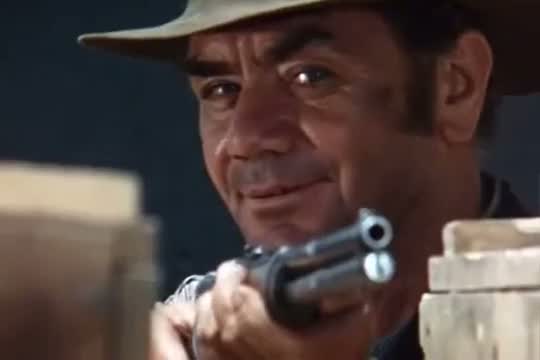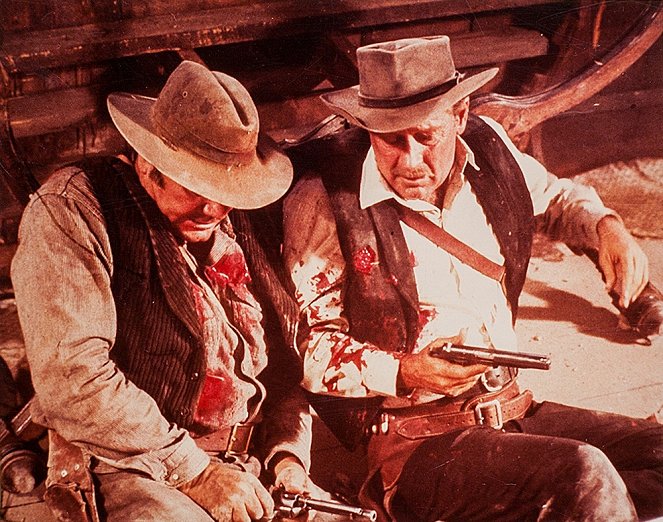Regie:
Sam PeckinpahKamera:
Lucien BallardMusik:
Jerry FieldingBesetzung:
William Holden, Ernest Borgnine, Robert Ryan, Edmond O'Brien, Warren Oates, Ben Johnson, Alfonso Arau, Strother Martin, L.Q. Jones, Albert Dekker (mehr)Inhalte(1)
1914, irgendwo zwischen Texas und Mexiko: Eine Bande von verwahrlosten Banditen reitet durch den Wilden Westen, verübt brutale Überfälle und gerät in atemlose Verfolgungsjagden. Die minuziöse Inszenierung von schonungsloser Gewalt und der großzügige Einsatz von Kunstblut erhitzten Ende der 1960er Jahre die Gemüter der Kritiker und Zuschauer. Die gefürchteten Outlaw-Banden des Wilden Westen sind zu Beginn des 20. Jahrhunderts nahezu ausgerottet, sie werden von Kopfgeldjägern gejagt und vom Gesetz verurteilt. Pike Bishop und seine Jungs sind eine der letzten Gaunerbanden, die ihr Unwesen in der Gegend um San Rafael, Texas, treiben. Hierher kommen sie auch, um das Büro der Eisenbahngesellschaft zu überfallen. Doch dort wartet schon Kopfgeldjäger Deke Thornton mit seiner Truppe auf sie - ein Hinterhalt! Die Parteien liefern sich eine Schießerei, die Stadt wird zum Schlachtfeld, doch Pike und seine Männer können nahezu unverletzt fliehen. Thornton, selbst ein ehemaliger Bandit und einst der beste Freund von Pike, wird ein Ultimatum gestellt: Binnen 30 Tagen soll er die Gauner dingfest machen, ansonsten geht es für ihn zurück ins Gefängnis.
So nimmt er mit seiner Truppe die Verfolgung auf. Auf der Flucht vor Thorntons Kopfgeldjägern gelangen Pike und seine Männer mitten in die Wirren der mexikanischen Revolution. Der dubiose General Mapache beauftragt sie, einen Waffentransport zu überfallen, um seine Armee mit den besten Waffen auszustatten. Der Coup gelingt und dieses Mal ist es Pike, der Thornton und seine Männer hereinlegt. Doch als die Verbrecher die Waffen an General Mapache übergeben, bemerkt dieser, dass der gebürtige Mexikaner Angel seinem Heimatdorf eine der 16 Waffenkisten zum Widerstand gegen das Militärregime überlassen hat. Angel wird getötet, woraufhin Pike und seine Männer Rache üben und ein wahres Blutbad anrichten - bei dem sie schließlich selbst das Zeitliche segnen.
(arte)
Videos (1)
Kritiken (9)
It is a bit paradoxical that the only film in Sam Peckinpah's filmography that I have a major problem with is the one that definitively captured the attention of film critics and audience interest. The Wild Bunch once fascinated people with its bloody violence (according to comments on FilmBooster, it still captivates many today, even though the standards have shifted and we are much more desensitized). Journalists tended to consider Peckinpah's film an artistic reflection of the Vietnam War or the rise of violent crime in American cities. Peckinpah, however, rejected one of the important genre rules. A classic western usually works with polarized black-and-white characters, where the positive hero faces villains. In The Wild Bunch, you will find exclusively more or less dirty characters, mostly driven by base motives. The director justified the behavior of his characters with instincts and animality, but this explanation lacks logic. Instincts have their own laws, and they function based on the need for defense, reproduction, acquiring food, and so on. The outbursts of violence in The Wild Bunch defy logical explanation. It is not about the film hero knowing less than the viewer and having only a fraction of the time for crucial decisions. The aggression in the film is actually built on effect, and the characters' decision-making is contrary to their interests and often even natural instincts. At the same time, I was disturbed by the use of humorous relieving elements. The film is strangely inconsistent in its pace, mood, and expressive means. On the other hand, Peckinpah is undoubtedly strong in his visual style with the slow motion technique and careful editing. Moreover, he utilizes the traditional advantages of westerns, expertly enchanting with panoramic shots of the beautiful and wild landscapes of the American Southwest. But sadly, this one won't be getting more than 2 stars from me. Overall impression: 45%.
()
Plenty of dead civilians as an inevitable part of a harsh life; men who only use the word "law" when it suits them; a woman as a symbol of a man's mere distraction... Sam Peckinpah had balls like no other director before or since, and the male superiority simply oozes out of his films. Yet it is a superiority that's honest, uncompromising, and harsh at the same time. This ensures that it can only be seen as an expression of an unmistakable creative genius, one that puts an almost mystical equivalence between the words violence and art and expands the film western to indescribable greatness.
()
A bloody masterpiece with several powerful scenes. In my opinion, stealing the weapons from the train is slightly better than simply a destructive finale. The setting, shortly before the outbreak of the world war, gives it the necessary feeling of the end of the Wild West as we know it, and the beginning of a new era.
()
By western standards, a solidly brutal film whose final machine-gun massacre in Aqua Verde is one of the most memorable scenes in the history of cinema. Sam Peckinpah just likes violence, The Wild Bunch doesn't look shabby in that respect and has a very realistic edge to it. This is also true of many scenes in which the horses in particular must have had a lot of fun (I would single out the slow-motion shots rolling down a sand dune and falling from a mined bridge into a river, which take on an almost bizarrely aesthetic impression). The production design with its impressive period Mexican realism with dirty hirsute locals is downright incredible. Women have no place in Peckinpah's harsh world of rough men, they only play the minor role of cheerleaders or treacherous bitches. Last but not least, we must mention William Holden (Sunset Boulevard), his charismatic performance brought back memories of his heyday in the 1950s.
()
For everything that happened after the train robbery, I would be delighted to give Peckinpah’s most famous picture full marks and I would also gladly place the Wild Bunch on the pedestal of best westerns right behind Leone’s masterpieces. But I can’t, I just can’t. What prevents me doing so it the hour it takes to get going. It’s not bad, but it is so desperately ordinary and confusable with any other western (with the exception of the opening sequence, of course) that it’s hard to watch.
()



Werbung